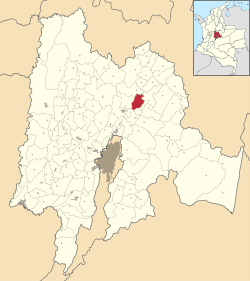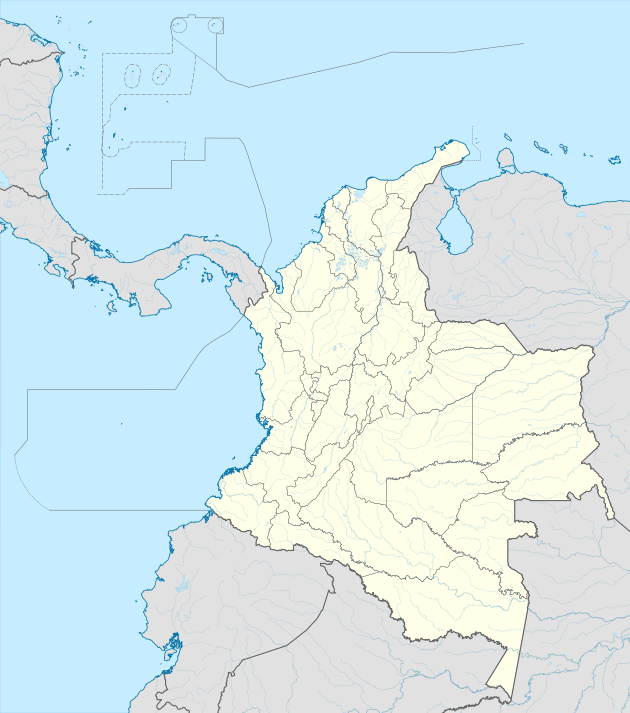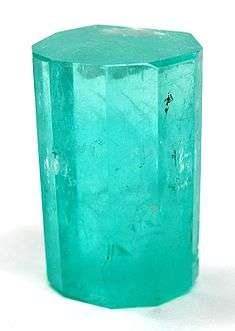Nemocón
Nemocón is a municipality and town of Colombia in the Central Savanna Province, part of the department of Cundinamarca. Nemocón, famous for its salt mine, was an important village in the Muisca Confederation, the country in the central Colombian Andes before the arrival of the Spanish. The municipality is situated in the northern part of the Bogotá savanna, part of the Altiplano Cundiboyacense with its urban centre at an altitude of 2,585 metres (8,481 ft) and 65 kilometres (40 mi) from the capital Bogotá. Nemocón is the northeasternmost municipality of the Metropolitan Area of Bogotá and the Bogotá River originates close to Nemocón. The median temperature of Nemocón is 12.8 °C. The municipality borders Tausa in the north, Suesca in the east, Gachancipá and Zipaquirá in the south and in the west the rivers Checua and Neusa and the municipality of Cogua.[1]
Nemocón | |
|---|---|
.jpg) Street in Nemocón | |
.svg.png) Flag | |
 Location of the town and municipality of Nemocón in the Cundinamarca Department | |
 Nemocón Location in Colombia | |
| Coordinates: 5°3′19″N 74°1′17″W | |
| Country | |
| Departamento | Cundinamarca |
| Province | Central Savanna Province |
| Founded | 26 July 1600 |
| Founded by | Luis Henríquez |
| Government | |
| • Mayor | Julián Alfredo Rodríguez Montaño (2020-2023) |
| Area | |
| • City | 98.1 km2 (37.9 sq mi) |
| • Urban | 0.61 km2 (0.24 sq mi) |
| Elevation | 2,585 m (8,481 ft) |
| Population (2015) | |
| • City | 13,488 |
| • Density | 140/km2 (360/sq mi) |
| • Urban | 5,684 |
| Demonym(s) | Nemoconense |
| Time zone | UTC-5 (Colombia Standard Time) |
| Area code(s) | +1 |
| Website | Official website |
Etymology
Nemocón is derived from Enemocón and means "The cry or sadness of the warrior" in the Chibcha language.[1] Another etymology is that the town is named after zipa Nemequene.[2]
History
Prehistory
Archaeological evidence surfaced by Gonzalo Correal Urrego in 1979 and Ana María Groot in 1992 has shown that Nemocón was inhabited early in the history of inhabitation of the Altiplano Cundiboyacense. One of the oldest evidence of human settlement; lithic scraper tools,[3] bone tools and the remains of food of the hunter-gatherers (deer, foxes, jaguars and rodents) has been dated at 7640 BP.[4] The inhabitants of the area lived under rock shelters, similar to Tequendama.[5]
Herrera Period
Checua
The archaeological site Checua, at 7 kilometres (4.3 mi) north from the urban centre of Nemocón, provided evidence carbon dated at around 6500 BCE. First researcher of Checua is female anthropologist and archaeologist Ana María Groot.[6] In later years other archaeological sites have been found.[7] Rock art has been discovered at various sites in Nemocón, among others at the border with Suesca.[8][9]
This lithic period, part of the Andean preceramic, predates the Herrera Period of which archaeological evidence has been found by Marianne Cardale de Schrimpff in 1975, 1976 and the 1980s.[10] Remains of deer, guinea pigs, rabbits, pecaris, howler monkeys and armadillos have been discovered in Nemocón and formed an important part of the diet of the people.[11][12][13] Ceramics of Nemocón date to the 4th century BC and showed that Nemocón in those ages was already important in the extraction of salt.[14] Excavations in Nemocón also have revealed the use of needles.[11]
Muisca
The Herrera Period was followed by the culturally advanced civilisation of the Muisca, organised in their loose Muisca Confederation. The Muisca Period typically commenced in 800 AD and the people were named Pueblo de la Sal; "Salt People" because of their trading in the product.[15][16] Ceramics of this period found in Nemocón originated from farther away on the Altiplano and ceramics of Nemocón and Zipaquirá found elsewhere on the Bogotá savanna are related to the salt trade.[17][18] Of the central Colombian indigenous peoples, only the Lache and U'wa were the other miners of salt. The Muisca exploited halite in various locations in their territories, among others in Nemocón, Zipaquirá, Sesquilé, Tausa, Gámeza, and Guachetá. Nemocón was a market town where the salt was traded.[19] A smaller salt mine was located in Sopó.[20] Early evidence of salt extraction dates back to the end of the first millennium BC.[21]
The Muisca women extracted the salt from a brine in large pots.[22][23][24] According to chronicler Juan de Santa Gertrudis, used the mineral to dry and preserve their fish and meat.[16]
Colonial period
During the Spanish colonial period, the salt was exploited by hand labour of the surviving Muisca.[25]
Modern Nemocón was founded on July 26, 1600 by Luis Henríquez.[1] As of 1614, wheat was successfully cultivated in Nemocón.[26]
Tourism
Famous for its salt mine and museum, Nemocón is a touristic village and linked by train from Bogotá. The salt mine is the second-largest of Colombia, after the Salt Cathedral in neighbouring Zipaquirá. Sunday is market day in Nemocón.[1]
Ferias
- Festival del floricultor
- September: Festival de Danzas
- December: Festival del macramé and Christmas lighting
Born in Nemocón
- Ricardo Moros Urbina, Painter s.XIX. Founder Colombian History Academy.
- Miguel Gutiérrez Nieto, Bogotá´s National Prefect and Major under Mosquera's presidency, S. XIX
- Eustacio Sanz de Santamaría, Foreign Affairs Secretary under Holguín's presidency. Diplomatic and writer
- Felipa Molina Morales and Antonio de Luna, Commoners revolution indigenous leaders.
- Luis Antonio Orjuela Quintero, Historian,. academic, educator.
- Manuel Medardo Espinosa, romantic poet.
- Julio Rubiano, former professional cyclist
Trivia
Gallery
- Central square of Nemocón
 House in Nemocón
House in Nemocón- Rural Nemocón
- Greenhouses in rural Nemocón
- Statue of Nemequene in Nemocón
- Entrance of the salt mine of Nemocón
.jpg) Salt mine
Salt mine- Salt mine
- Salt mine
- Salt mine
See also
References
- (in Spanish) Official website Nemocón Archived 2015-05-20 at Archive.today
- Espejo Olaya, 1999, p.1121
- Schrimpff, 1985, p.103
- (in Spanish) Colombia prehispánica - V. La Altiplanicie Cundiboyacense
- Correal Urrego, 1990b, p.71
- Groot, 1992, p.8
- (in Spanish) Periodos de los Sitios Arqueológicos
- (in Spanish) Caracterización de los sitios arqueológicos
- (in Spanish) Murales rupestres policromos en la Sabana de Bogotá
- Correal Urrego, 1990a, p.12
- Schrimpff, 1985, p.116
- Rivera Pérez, 2013, p.74
- Cooke, 1998, p.187
- (in Spanish) Ocupaciones humanas en el Altiplano Cundiboyacense - la Etapa Cerámica vista desde Zipaquirá
- Daza, 2013, p.21
- Daza, 2013, p.22
- De Paepe & Schrimpff, 1990, p.102
- Argüello García, 2015, p.43
- Restrepo Manrique, 2012, p.35
- Schrimpff, 1985, p.114
- Schrimpff, 1985, p.117
- Zerda, 1882, p.131
- Zerda, 1882, p.133
- Zerda, 1882, p.140
- Restrepo Manrique, 2012, p.36
- Restrepo Manrique, 2012, p.62
- (in Spanish) El mastodonte de Nemocón
Bibliography
- Argüello García, Pedro María. 2015. Subsistence economy and chiefdom emergence in the Muisca area. A study of the Valle de Tena (PhD), 1–193. University of Pittsburgh. Accessed 2016-07-08.
- last= [{ Germán Caballero Herrera| last Caballero Herrera |first= Germán|year=2011|title=Lamento de guerrero-Monografía de Nemocón Alcaldía Municipal| ISBN 978-958-99927-0-8}}
- Cardale de Schrimpff, Marianne. 1985. En busca de los primeros agricultores del Altiplano Cundiboyacense - Searching for the first farmers of the Altiplano Cundiboyacense, 99–125. Banco de la República. Accessed 2016-07-08.
- Cooke, Richard. 1998. Human settlement of Central America and northernmost South America (14,000-8000 BP). Quaternary International 49/50. 177-190.
- Correal Urrego, Gonzalo. 1990. Aguazuque: Evidence of hunter-gatherers and growers on the high plains of the Eastern Ranges, 1-316. Banco de la República: Fundación de Investigaciones Arqueológicas Nacionales. Accessed 2016-07-08.
- Correal Urrego, Gonzalo. 1990. Evidencias culturales durante el Pleistocene y Holoceno de Colombia - Cultural evidences during the Pleistocene and Holocene of Colombia. Revista de Arqueología Americana 1. 69–89. Accessed 2016-07-08.
- Daza, Blanca Ysabel. 2013. Historia del proceso de mestizaje alimentario entre Colombia y España - History of the integration process of foods between Colombia and Spain (PhD), 1-494. Universitat de Barcelona.
- Espejo Olaya, Maria Bernarda. 1999. Notas sobre toponimia en algunas coplas colombianas - Notes about toponomy of some Colombian ballads - Thesaurus, 1102-1157. Tomo LIV, Núm. 3.; Accessed 2016-07-08.
- Groot de Mahecha, Ana María. 2014 (2008). Sal y poder en el altiplano de Bogotá, 1537-1640, 1-174. Universidad Nacional de Colombia.
- Groot de Mahecha, Ana María. 1992. Checua: Una secuencia cultural entre 8500 y 3000 años antes del presente - Checua: a cultural sequence between 8500 and 3000 years before present, 1-95. Banco de la República. Accessed 2016-07-08.
- Paepe, Paul de, and Marianne Cardale de Schrimpff. 1990. Resultados de un estodio petrológico de cerámicas del Periodo Herrera provenientes de la Sabana de Bogotá y sus implicaciones arqueológicas - Results of a petrological study of ceramics form the Herrera Period coming from the Bogotá savanna and its archaeological implications. Boletín Museo del Oro _. 99-119. Accessed 2016-07-08.
- Restrepo Manrique, Cecilia. 2009. La alimentación en la vida cotidiana del Colegio Mayor de Nuestra Señora del Rosario: 1653-1773 & 1776-1900 - The food in the daily life of the Colegio Mayor de Nuestra Señora del Rosario: 1653-1773 & 1776-1900, 1–352. Ministerio de la Cultura. Accessed 2016-07-08.
- Rivera Pérez, Pedro Alexander. 2013. Uso de fauna y espacios rituales en el precerámico de la sabana de Bogotá - Use of fauna and ritual spaces in the preceramic of the Bogotá savanna. Revista ArchaeoBIOS 7-1. 71-86.
- Zerda, Liborio. 1947 (1883). El Dorado. Accessed 2016-07-08.
External links
| Wikimedia Commons has media related to Nemocón. |
- (in English and Spanish) Salt mine of Nemocón - official website
- Video of Nemocón

